A site has assigned the ICMP monitor to all nodes and a custom monitor, based on the HTTP template, to a pool of web servers. The HTTP based monitor is working in all cases. The ICMP monitor is failing for 2 of the
pool member 5 nodes. All other settings are default. What is the status of the monitor is working in all cases?
A virtual server is listening at 10.10.1.100:any and has the following iRule associated with it:
when CLIENT_ACCEPTED { if {[TCP::local_port] equals 80 } { pool pool1 } elseif {[TCP::local_port] equals 443} { pool pool2 }
If a user connects to 10.10.1.100 and port 22, which pool will receive the request?
Refer to the exhibit.
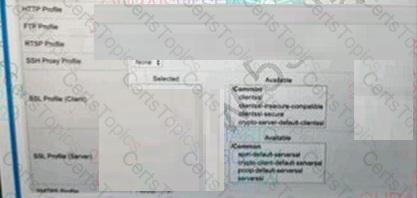
A BIG-IP Administrator configures a Virtual Server to handle HTTPS traffic. Users report that the
application is NOT working.
Which actional configuration is regard to resolve this issue?
Assume a client's traffic is being processed only by a NAT; no SNAT or virtual server processing takes place. Also assume that the NAT definition specifies a NAT address and an origin address while all other settings are
left at their defaults. If the origin server were to initiate traffic via the BIG-IP, what changes, if any, would take place when the BIG-IP processes such packets?
Which event is always triggered when a client initially connects to a virtual server configured with an HTTP profile?
In the BIG-IP Configuration Utility, a user requests a single screen view to determine the status of all Virtual Servers and associated pool members, as well as any iRules in use. Where should the BIG-IP Administrator instruct the user to find this view?
The BIG-IP Administrator disable all pool members in a pool Users are still able to reach the pool
members.
What is allowing users to continue to reach the disabled poo! members?
What is required for a virtual server to support clients whose traffic arrives on the internal VLAN and pool members whose traffic arrives on the external VLAN?
Refer to the exhibit.

How many nodes are represented on the network map shown?
Assume the bigd daemon fails on the active system. Which three are possible results? (Choose three.)
A custom HTTP monitor is failing to a pool member 10.10.3.75:8080 that serves up
A ping works to the pool member address.
The SEND string that the monitor is using is:
Close/r/n/r/n
Which CLI tool syntax will show that the web server returns the correct HTTP response?
Which statement describes a typical purpose of iRules?
To increase available bandwidth of an existing Trunk, the BIG-IP Administrator is adding additional
interfaces.
Which command should the BIG-IP Administrator run from within bosh shell?
As a part of the Setup Utility, the administrator sets the host name for the BIG IP. What would be the result if the two systems in a redundant pair were set to the same host name?
Which Virtual Server type prevents the use of a default pool?
Refer to the exhibit.
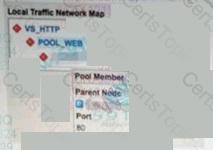
Why is the virtual server responsive to incoming connections?
An ecommerce company is experiencing latency issues with online shops during Black Friday's peak season.
The BIG-IP Administrator detects an overall high CPU load on the BIG-IP device and wants to move the
top utilized Virtual Servers to a dedicated BIG-IP device.
Where should the BIG-IP Administrator determine the problematic Virtual Servers?
A BIG-IP Administrator needs to collect HTTP status code and HTTP method for traffic flowing through a
virtual server.
Which default profile provides this information?
All pool members are online. All other virtual server settings are at default What might after the load balancing behavior?
A BIG-IP Administrator uses backend servers to host multiple services per server. There are multiple virtual servers and pools defined, referencing the same backend servers.
Which load balancing algorithm is most appropriate to have an equal number of connections on each backend server?
A standard virtual server has been associated with a pool with multiple members. Assuming all other settings are left at their defaults, which statement is always true concerning traffic processed by the virtual server?
Refer to the exhibit.
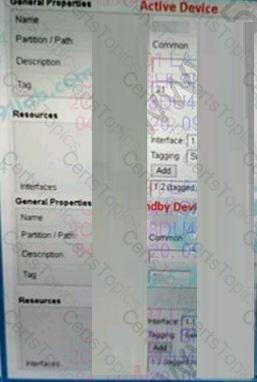
During a planned upgrade lo a BIG-IP HA pair running Active/Standby, an outage to application traffic is reported shortly after the Active unit is forced to Standby Reverting the flower resolves the outage. What should the BIG-IP Administrator modify to avoid an outage during the next for over event?
A BIG-IP Administrator makes a configuration change to the BIG-IP device. Which file logs the message regarding the configuration change?
When configuring a Virtual Server to use an iRule with an HTTP_REQUEST event, which lists required steps in a proper order to create all necessary objects?
A site needs a virtual server that will use an iRule to parse HTTPS traffic based on HTTP header values. Which two profile types must be associated with such a virtual server? (Choose two.)
Assuming other failover settings are at their default state, what would occur if the failover cable were to be disconnected for five seconds and then reconnected?
The current status of a given pool is offline (red). Which condition could explain that state? Assume the descriptions below include all monitors assigned for each scenario.
How is persistence configured?
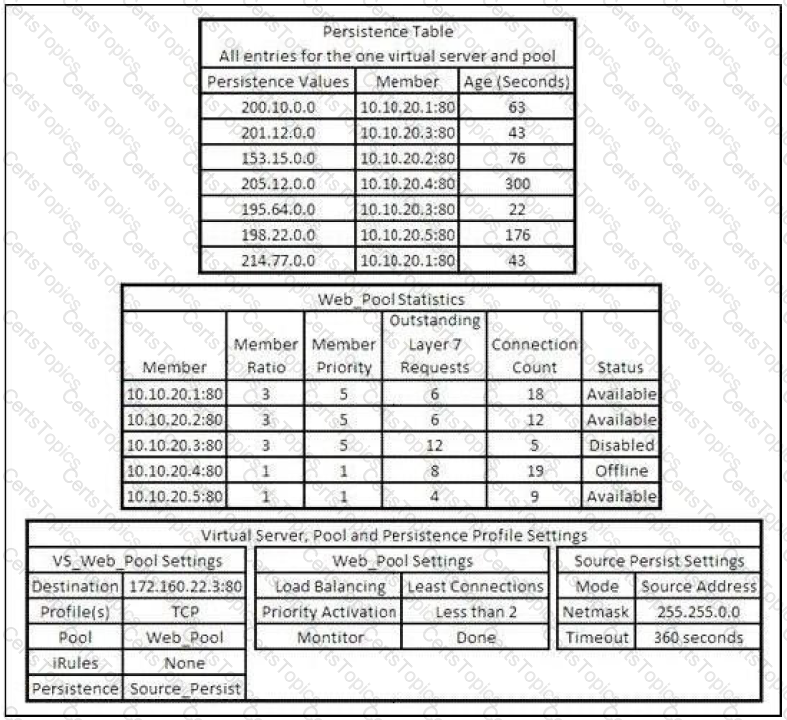
A BIG-IP Administrator has configured a BIG-IP cluster with remote user authentication against dcOl
f5trn.com. Only local users can successfully log into the system. Configsync is also failing.
Which two tools should the 8IG-IP Administrator use to further investigate these issues? (Choose two)
When using the setup utility to configure a redundant pair, you are asked to provide a "Failover Peer IP". Which address is this?
A BIG-IP Administrator contacts F5 Support, which identifies a suspected hardware failure. Which information should the BIG-IP Administrator provide to F5 Support?
What should the BIG-IP Administrator do to apply and activate a hotfix to a BIG-IP device that is currently running version 11.0.0 on active partition HD1.1?
Refer to the exhibit.
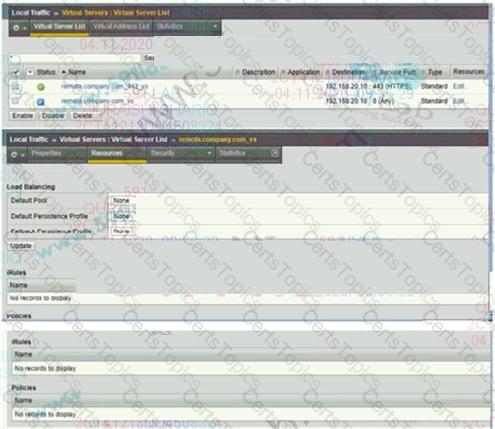
A user notifies the BIG-IP Administrator that company.com is NOT accessible. Remote
access to company resources must be encrypted.
What should the BIG-IP Administrator do to fix the issue?
A site is load balancing to a pool of web servers. Which statement is true concerning BIG IP's ability to verify whether the web servers are functioning properly or not?
A BIG-IP Administrator is creating a new Trunk on the BIG-IP device. What objects should be added to the new Trunk being created?
Which type of Virtual Server requires the use of a FastL4 profile?
A BIG-IP Administrator plans to upgrade a BIG-IP device to the latest TMOS version.
Which two tools could the administrator leverage to verify known issues for the target versions?
(Choose two.)
A BIG-IP Administrator uses a device group to share the workload and needs to perform service on a BIG-IP device currently active for a traffic group. The administrator needs to enable the traffic group to run on another BIG-IP device in the device group. What should the administrator do to meet the requirement?